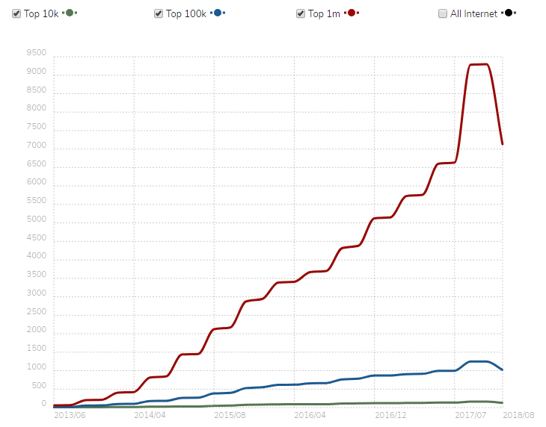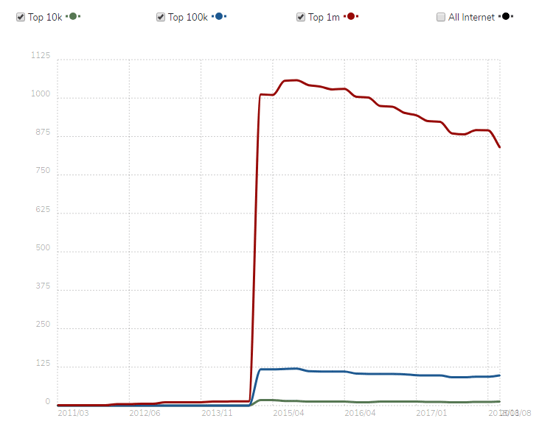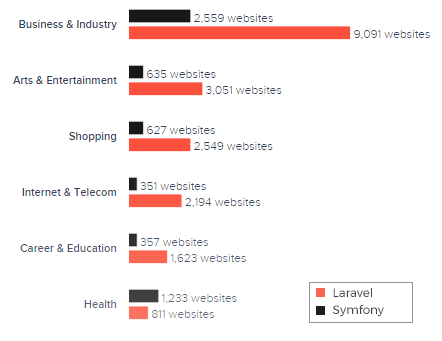
Despite a number of programming languages originating to support the modern, dynamic web requisites, PHP is still holding its ground. The popularity of this general-purpose, server-side programming language can be estimated from the fact that over 4 million live websites are using PHP. | Source: Builtwith.com
However, as websites and web apps become more complex and dynamic, Core PHP limits developers to speed up the development cycle. This is where, PHP frameworks comes in, enabling developers to scale their system easily, reduce the lines of code, and accelerate development speed.
Amongst the various PHP frameworks available to simplify web application development, laravel and Symfony are two of the most popular frameworks. Making a choice between the two depends upon a variety of technical and non-technical factors, including market share, website categories supported, CI capability, templating engines etc.
Laravel vs Symfony, let’s have an overview of these PHP frameworks and understand which one will work best for your next web app development project.
Laravel: Overview
Laravel is an open-source PHP web development MVC framework, created by Taylor Otwell. Fundamentally based on the MVC architecture, the framework makes it easier for developers to build web applications using simple, expressive syntax.
Laravel is built on over 20 different, object oriented libraries that differentiates it from rest of the PHP frameworks. The framework comes built-in with a command line interface called Artisan, which offers a number of helpful commands to simplify development cycle.
Symfony: Overview
Symfony is a PHP web application framework. It has a set of decoupled, reusable PHP components/libraries on which some of the major PHP applications are built, including Drupal, eZ Publish, phpBB etc.
Symfony is heavily inspired by Spring framework that makes use of existing open-source PHP projects including Doctrine as object-relational mapping layers, Twig as templating engine, PHPUnit as Unit Testing framework etc.
Laravel vs Symfony: Non-Technical Aspects
Number of Websites
According to SimilarTech, Laravel is used by 74,494 websites whereas Symfony by 12,715 websites. If the popularity and usage statistics are compared on the basis of number of websites that use Laravel vs Symfony, Laravel comes out to be a definite winner.
Winner: Laravel
Market Share
Laravel is leading in top 10K sites, top 100K sites, top 1M sites and almost entire web. However, despite the recent growth, Symfony is still behind Laravel in all market share segments.
Here is a usage report from builtwith.com that highlights the market share captured by Laravel and Symfony.


Laravel has better usage coverage in more websites categories- Business & Industry, Arts & Entertainment, Shopping, Internet & Telecom and 210 other categories. On the other hand, Symfony is leading in categories like Health, Dentistry, Medicine etc.

Source: Similartech.com
Winner: Laravel
Geography
Laravel is leading in most countries, including United States, Russia, Brazil, United Kingdom and 196 other countries. On the other hand, Symfony is leading in Mongolia, Luxembourg, Réunion, French Polynesia and 3 other countries. | Source: SimilarTech
Winner: Laravel
Laravel vs Symfony: Technical Aspects
Project Handling
Both Laravel and Symfony are based on MVC architect. But when it comes to crafting codes, Symfony is considered a reliable option for code reusability and modularity in coding. For this, Symfony is better for complex, scalable projects.
Another factors that can be considered when doing Laravel vs Symfony comparison is the template engine for both the frameworks. Laravel has Blade and Symfony has Twig. Since Blade offers code reusability facility, it speeds up development by enabling programmers to use a same function twice (which doesn’t happen in Twig).
Winner: Laravel
Documentation and Learning Curve
In terms of documentation and learning material, Laravel wins the game over Symfony. For developers to get started building apps with Laravel, there are detailed tutorials and support videos available, called Laracasts. On the other hand, Symfony’s documentation is available with obvious documentation about components, bundles, service containers etc. Talking about the learning curve, learning to code with Symfony needs more time and technical expertise than Laravel.
Winner: Laravel
Performance and Scalability
The performance of both the frameworks can be judged through the loading speed of the page. Both Symfony and Laravel caches views. However, Symfony caches the source code as well. Since Laravel is made using Symfony, it has got performance improvement. The average loading time for Laravel websites is 60 milliseconds while for Symfony, it is 250 milliseconds.
Winner: Laravel
Laravel vs Symfony: The Verdict
Both Laravel and Symfony are viable options for building robust, scalable PHP-projects. Making a choice between the PHP frameworks depends upon resource availability, project complexity, and long-term development plans.
Choose Symfony, when you have complex PHP application development requirements and have access to skilled developers. However, if you a small or mid size project and accelerating development cycle is the need, then Laravel might be a better option.




